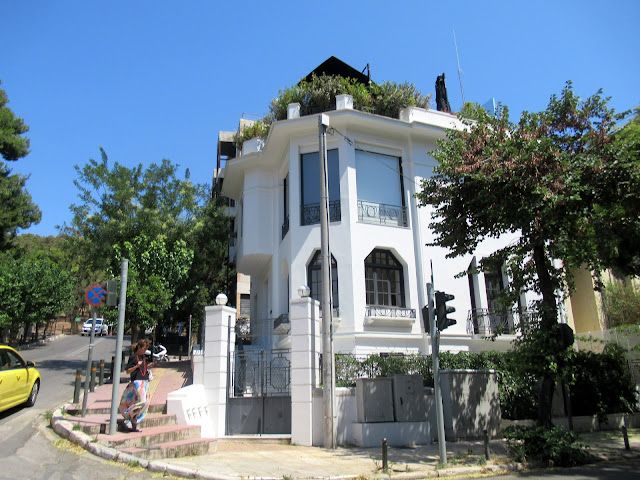Anselm Kiefer in Athens, at the Gagosian Gallery.
Anselm Kiefer is an artist that I would travel miles to see the work of, so, how lucky that there is an exhibition of his work in Athens. Only six paintings, nothing, compared to the monumental exhibition at the RA which you can see here or the one in Vienna which is here or the other monumental one at the White Cube gallery in London which you can see here . I also enjoyed the exhibition of his work in Berlin which you can see here , in Coventry here or the one about Paul Celan here
I don't usually start a post with references to previous ones, but Kiefer is such a giant amongst artists, his work is so varied and so overwhelming and all-encompassing, that I really want to share his work with you.
The bulk of Kiefer's work addresses Germany's past, the Holocaust and its horrors. He creates monumental history paintings, he resurrects the horrors of the 20th century in a shocking and explicit way and he is determined not to allow us to forget. In his abstract paintings he uses ash, sand, gold leaf, lead, sunflower seeds, straw, fabric, shellac, acrylic paint.
The theme of this exhibition is different. These landscapes convey responses to myth, history and the natural world, evoking myths of creation, metamorphosis, and the cyclical nature of existence. The usual Kiefer materials have been used, but this time, they are contrasted and juxtaposed with the luminosity of gold. He alludes to gold's allegorical significance by making reference to the metal's use in sacred icons and ancient legends, its alchemical symbolism in relation to lead (another key material in his practice) and the ideal of a 'golden age'.
The theme of this exhibition is different. These landscapes convey responses to myth, history and the natural world, evoking myths of creation, metamorphosis, and the cyclical nature of existence. The usual Kiefer materials have been used, but this time, they are contrasted and juxtaposed with the luminosity of gold. He alludes to gold's allegorical significance by making reference to the metal's use in sacred icons and ancient legends, its alchemical symbolism in relation to lead (another key material in his practice) and the ideal of a 'golden age'.
Needless to say, that these paintings need to be experienced in the actual space - photographs in a blogpost are just pale renditions.
Nehebkau is titled after an ancient Egyptian deity who took the form of a snake with human legs and served as a guardian of the underworld and binder of the ka, or vital essence of the soul. Inscribing hieroglyphics in the painting's upper register, Kiefer incorporates straw, terra-cotta, gold leaf, the sediment of a copper solution that has undergone electrolysis, and paint, juxtaposing material presence and motifs of transcendence.
Ignis Sacer, 2014
The sculpture housed in the vitrine contains scattered flakes of gold that read as a foreign substance among stalks of wheat. In addition to suggesting the sacred connotations of gold, the gold leaf symbolizes Ignis Sacer (holy fire) or ergotism, a disease spread by a fungus that contaminates grain and causes mania, hallucinations and death. Understood as divine punishment during the Middle Ages, the disease was widespread, with repeated outbreaks in the Rhine Valley. In addition to evoking the sacred, mythic and historical, Kiefer's work addresses the complexity of humanity's relationship with nature, which both sustains and threatens life.
Danae, 2023, (emulsion, oil, acrylic, shellac, gold leaf on canvas) (280 cm x 380 cm)
The only way I could photograph the whole of this painting was sideways as, like the others, it's huge and this space was quite narrow.
This is one of two paintings that interpret a myth that has inspired artists from Titian and Rembrandt to Gustav Klimt. The mythological figure of Danae was imprisoned by her father, King Acrisius of Argos, in response to a prophecy that her son would kill him. Zeus circumvented her prison walls by transforming himself into a shower of gold, leading to the conception of Perseus. This painting portrays Danae's prison as an ancient tomb with a corbeled dome that Kiefer encountered in Greece, surrounded by windswept foliage described by thick brushstrokes.
looking closer at the entrance to the dome
such thick brushstrokes

close up of some of the sunflowers
such thick brushstrokes
Danae, 2023, (emulsion, oil, acrylic, shellac, resin, and gold leaf on canvas)
This painting recalls the act of transfiguration that is central to the myth, representing a row of black sunflowers on a gold ground with gold seeds that appear to fall down its surface.
looking closer at the middle of the painting

close up of some of the sunflowers
Exploring sacred and mythological themes in terms of landscape, this painting depicts an isolated rocky outcropping off the southwestern coast of Italy, rendering its rugged forms in vibrant gold, in contrast with the dark hues of the Mediterranean.
This is a photograph printed on a gilded panel of a sculpture of a sunken naval ship taken at Kiefer's studio in France. It's reminiscent of the shipwreck painted by Caspar David Friedrich in his sublime arctic scene Das Eismeer (The Sea of Ice), (1823-24). This work's striking golden ground reflects Kiefer's experimental approach to photography.




















No comments:
Post a Comment